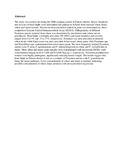Head blight of wheat in Kenya and contamination of grain with mycotoxin producing Fusarium species

Date
2008Author
Muthomi, J.W
Riungu, G.M
Ndung`u, J.K
Narla, R.D
Gathumbi, J.K
Wagacha, J.M
Type
ArticleLanguage
enMetadata
Show full item recordAbstract
The study was carried out during the 2006 cropping season in Nakuru district, Kenya. Incidence and severity of head blight were determined and pathogens isolated from diseased wheat heads, wheat and maize kernels. Mycotoxin deoxynivalenol content in grain was determined by direct competitive Enzyme-Linked Immunosorbent Assay (ELISA). Pathogenicity of different Fusarium species isolated from wheat was determined by inoculation onto wheat ears in greenhouse. Head blight was highly prevalent (90-100%) and mean incidence and severity ranged from 4 to 9% and 15 to 37%, respectively. Fusarium was most prevalent in infected wheat heads while Epicoccum was most prevalent in harvested wheat grain. Only Fusarium spp. and Penicillium spp. contaminated harvested maize grain. The most frequently isolated Fusarium species were F. poae, F. graminearum and F. chlamydosporum in wheat and F. verticilloides in maize. Most wheat and maize grain samples were contaminated with mycotoxin (DON), with concentration ranging from 0-1,200 and 0-4,600 µg kg-1, respectively. Fusarium graminearum isolates were highly pathogenic, significantly reducing kernel weight. The results suggest that head blight in Nakuru district is due to a complex of Fusarium species with F. graminearum being the major pathogen. Cross-contamination of wheat and maize is implied, indicating possible contamination of wheat maize products with deoxynivalenol mycotoxin.
URI
http://www.scialert.net/fulltext/?doi=jps.2008.52.60&org=10http://erepository.uonbi.ac.ke:8080/xmlui/handle/123456789/30101
